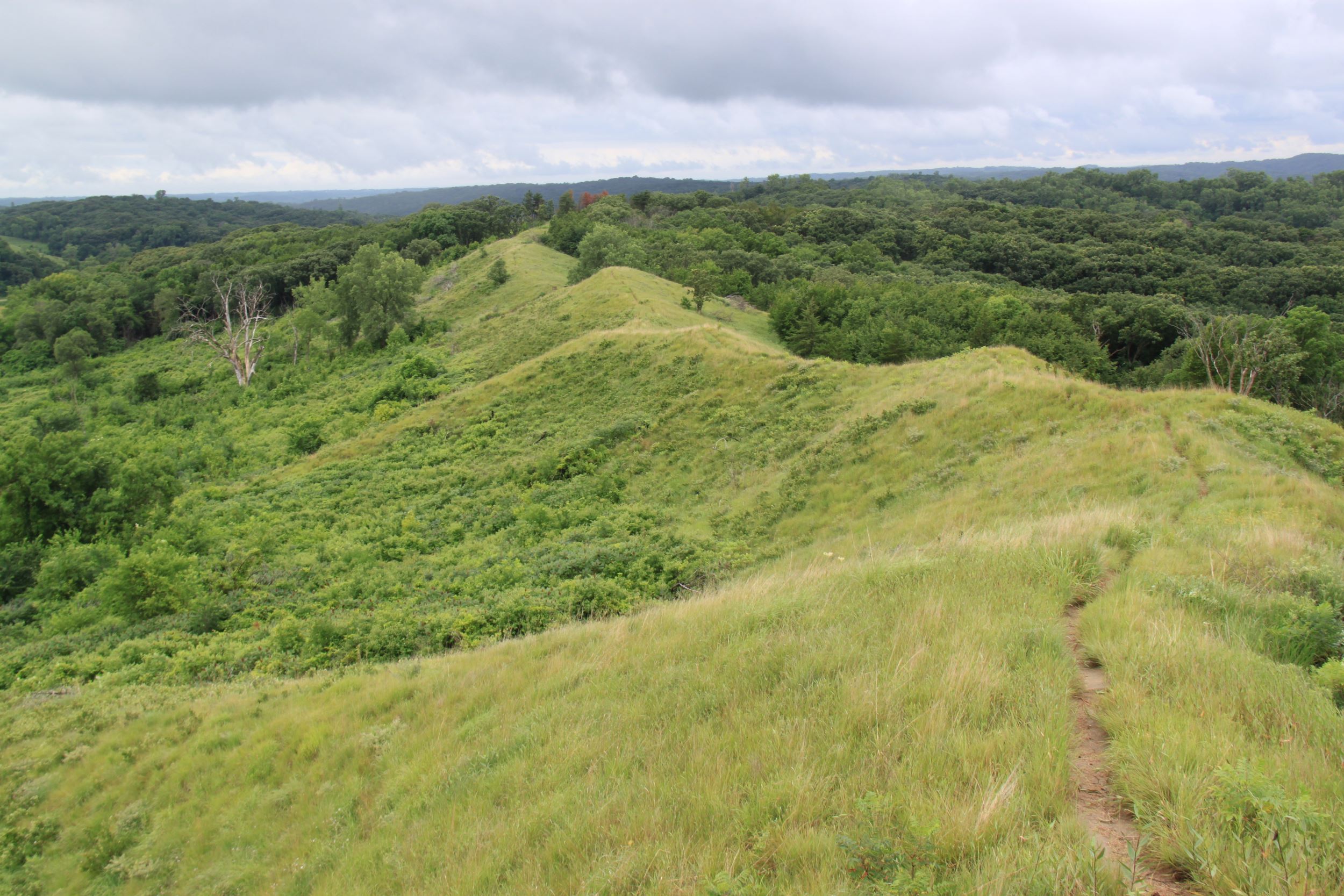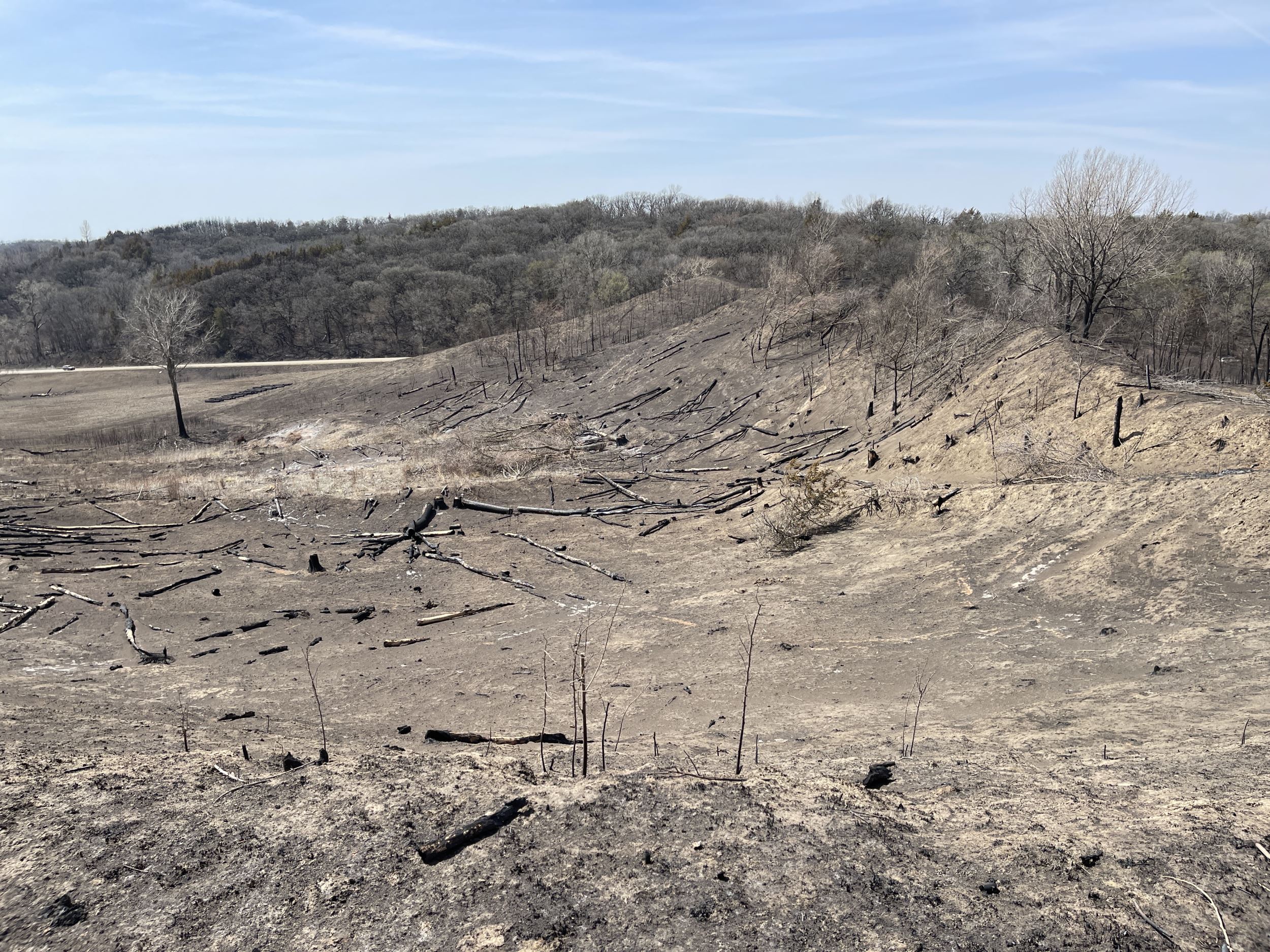Protection Patchwork
By Erica Place on February 9, 2024 in Blog

Photo by Carter Oliver
Best known for expansive prairie landscapes and fragile, windblown soil, Iowa’s Loess Hills also boast large tracts of forest. The north and east slopes of the steep ridges, shielded from the hot afternoon sun and strong winds, historically supported woodland communities. Combined with the prairie on opposing slopes and savanna in between, the mosaic landscape offers countless outdoor recreation opportunities and food and shelter for a wide array of wildlife. Around 11,500 acres of this mixed habitat now make up the Loess Hills State Forest, a patchwork of protected land in Harrison and Monona counties.
Room to Roam
Like our other state forests, the Loess Hills State Forest is managed by the Iowa Department of Natural Resources with a handful of environmental and economic goals in mind. In addition to safeguarding Iowa’s timber resources, the state forests provide rugged outdoor experiences and protect water quality and contiguous, diverse wildlife habitat.
How habitat is arranged is as important as quality or quantity. Plant and animal populations tethered to postage stamps of habitat are isolated and segmented. Without a connection to other pockets of the woodland, prairie or wetland they need, individuals are less able to cope with challenges like disease, severe weather or predation. Corridors of protected land, like in the Loess Hills State Forest, give plants and animals room to move. Projects that connect existing habitat are a high priority.
Wildfire Strikes
On April 13, 2023, a large portion of this state forest and the surrounding area was reminded of the importance of contiguous habitat and how quickly things can change. The prolonged drought had made things critically dry, and a combination of dangerous temperature, humidity and wind conditions meant there was high risk for extreme fire danger. It was no surprise when trash set ablaze on private property just southwest of Preparation Canyon State Park escaped the burn barrel.
The Loess Hills Fire Partners — a highly skilled group of firefighters from various local conservation organizations — sprang into action. Private residences, the Scenic Overlook platform and the state forest at large were all in jeopardy. Fifty-eight conservation professionals across western Iowa, including INHF staff, worked 28 hours straight to contain the fire, which ultimately burned 3,770 acres. The intensity of this fire was different than what you’d see in a prescribed burn meant to invigorate native species. It was unprecedented.
 “This was a catastrophic, stand-replacing wildfire,” said Jeff Seago, DNR Area Forester for the Loess Hills State Forest. “We think somewhere in the neighborhood of 640 acres of trees were immediately killed or mortally wounded. That’s a square mile.”
“This was a catastrophic, stand-replacing wildfire,” said Jeff Seago, DNR Area Forester for the Loess Hills State Forest. “We think somewhere in the neighborhood of 640 acres of trees were immediately killed or mortally wounded. That’s a square mile.”
Wildlife able to flee found reprieve in the parts of the complex the fire didn’t reach, but the area saw significant deciduous tree mortality and scorched earth completely void of life. The top couple of inches of soil were essentially cooked. Weeks after, when you’d expect to see things resprout, the land remained black. At the time of the fire, it’s estimated that bur oak (Quercus macrocarpa) and black walnut (Juglans nigra) barks’ moisture content was hovering around 17%. By comparison, quality seasoned firewood has a moisture content of 20% or lower. The forest was one big bundle of kindling.
The badly burned areas, now largely a blank slate, will face substantial challenges with invasive species such as black locust (Robinia pseudoacacia). Seago and others will have to implement heavy-handed strategies to salvage residual timber and help the forest recover. As devastating as the wildfire was, there are some silver linings.
“This gives us the opportunity to create larger blocks of young forest relied upon by declining species like Eastern Whip-poor-will (Antrostomus vociferus) and Northern Bobwhite (Colinus virginianus). It will also mean better connectivity between existing prairie areas, so pollinators and other grassland dwellers have safer travel corridors,” Seago said.
Puzzle Piece
Just north of Pisgah and straight east of the Little Sioux Scout Ranch, a nearly 1,800-acre scout camp that INHF purchased in 2022, lies a 191-acre property in the heart of Loess Hills woodland. Its bur oak forest and prairie remnant ridges had been well cared for; species like locoweed (Oxytropis lambertii pursh), Missouri milkvetch (Astragalus missouriensis) and skeletonweed (Lygodesmia juncea) point to its quality. Despite a long history of prescribed fire on the property, a portion of the woodland was badly burned in the Jones Creek Wildfire. An opportunity to permanently protect the property came up late last summer when it was listed for sale, and agreeing they’d rather not see the property subdivided or the grassland removed, the family chose to sell to INHF.
“It’s good to know this habitat can remain contiguous,” said Kody Wohlers, INHF’s Loess Hills Land Stewardship Director. “Puzzle pieces like this mean plants and animals can move freely and it gives land stewards options for more holistic natural resource management.”
It’s among the most recent of INHF’s protection projects in the Loess Hills; more than 75% of this Special Landscape Area — one of twelve areas recognized by the National Park Service that signify especially important natural lands — is unprotected. But through projects like this and land voluntarily protected by private landowners with conservation easements, we and other conservation partners across the Loess Hills are working to fill in this patchwork of protection so the landscape is resilient, even when disaster strikes.